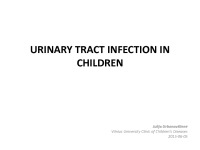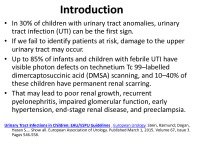Urinary Tract Infection In Children



Urinary tract infection in children. Urinary tract infection. Introduction. Background. Microbiology. Classification. Classification according to site. Classification according to episode. Classification according to symptoms. Classification according to complicating factors. Atypical uti. “Seriously Ill”. Recurrent uti. Pathogenesis. Risk Factors. Bacterial factors that. Predispose to infection. Vesicoureteric reflux. Pathogenesis. Grading. Risk Factors for Renal Scarring. Diagnostic work-up. Medical history. Clinical signs and symptoms. Factors distinguishing between upper UTI and lower UTI. Physical examination. Urine sampling, analysis, and culture. Newborns, infants, and non–toilet-trained children urine sampling. Toilet-trained children urine sampling. Urine analysis. Urine culture. Table. Blood test. Imaging Procedures. Routine imaging (USUltrasound. Abnormal Ultrasound Findings. Society of Fetal Urology Classification of Prenatal and Postnatal Hydronephrosis. Duplicated Collecting Systems. Mcug. Dmsa scan. Timing of dmsa. Dmsa. Risk of Renal Parenchymal Defects. Renal Parenchymal Defects. Renal Damage. Investigations following UTI in infants under 6 months of age. Investigations following UTI in children of 6 months to 3 years. Of age. Investigations following UTI in children over 3 years of age. Acute pyelonephritis diagnostic criteria in children. Acute cystitis diagnostic criteria in children. Chronic cystitis diagnostic criteria in children. Hospitalization is necessary for the following patients with UTI. Therapy. Asymptomatic bacteriuria (ABUCystitis in children >3 mo of age. Febrile children administration route. Duration of therapy in febrile urinary tract infection. Recommended initial pyelonephritis treatment. Acute cystitis or exacerbations of chronic cystitis treatment. Antimicrobial agents. Frequently used antibacterial agents for treatment of paediatric urinary tract infections. Recommendations for calculated antibacterial therapy of pyelonephritis dependent on age and severity of infection. Recommended antibacterial treatment for cystitis and cystourethritis. Prophylaxis. Possibilities for antibacterial prophylaxis. Monitoring of urinary tract infection. Complications. Prognosis. Bladder and bowel dysfunction (BBDConclusions.
Newborns, infants, and non–toilet-trained children urine sampling (1).
Newborns, infants, and non–toilet-trained children urine sampling (2).
Newborns, infants, and non–toilet-trained children urine sampling (3).
Newborns, infants, and non–toilet-trained children urine sampling (4).
Urinary Tract Infections in Children, Diagnostic Imaging based on Clinical Practice Guidelines, Emily D. Kucera, M.D., Assistant Professor, UMKC.
Fever of 38 ° C or higher Leucocyturia Significant bacteriuria Changes in blood showing a bacterial infection (leukocytosis, CRP > 20 mg/l) General signs of inflammation (intoxication, abdominal, flank pain) Changes in echoscopy To confirm diagnosis there must be urine abnormality and at least two other criteria.
Urinary disturbances Leucocyturia Significant bacteriuria To confirm diagnosis there must be urinary disturbances and at least one other criteria.
History of acute cystitis Urinary disturbances Leucocyturia Significant bacteriuria Bladder wall abnormalities were identified by ultrasound To confirm diagnosis there must be more than two criteria.
Aminoglycosides IV until the child has a fever and an additional 1-2 days, but no longer than 7 days, then other antibacterial drug by antibiogram until 10-14 days or Group 2 cephalosporins IV until the child has a fever and an additional 1-2 days, then PO until 10-14 days (by antibiogram).
- Medicine Presentations
- MS PowerPoint 1343 KB
- 2021 m.
- English
- 87 pages (5490 words)
- University
- Julija
















